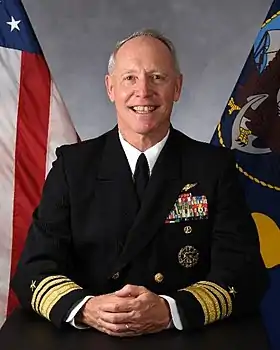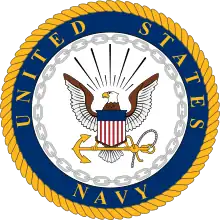Commander, Naval Air Forces
Commander, Naval Air Forces (a.k.a. COMNAVAIRFOR, and CNAF; and dual-hatted as Commander, Naval Air Force, Pacific, and COMNAVAIRPAC) is the aviation Type Commander (TYCOM) for all United States Navy naval aviation units. Type Commanders are in Administrative Control (ADCON), and in some cases Operational Control (OPCON) of certain types of assets (ships, submarines, aircraft, and Fleet Marines) assigned to the Pacific and Atlantic Fleets. AIRFOR is responsible for the materiel readiness, administration, training, and inspection of units/squadrons under their command, and for providing operationally ready air squadrons and aircraft carriers to the fleet.
| Commander, Naval Air Forces and Commander, Naval Air Forces Pacific CNAF (COMNAVAIRFOR) and CNAP (COMNAVAIRFORPAC) | |
|---|---|
 Insignia of the Commander, Naval Air Forces and Commander, Naval Air Forces Pacific | |
| Department of the Navy | |
| Reports to | Chief of Naval Operations United States Pacific Fleet |
| Seat | Naval Air Station North Island |
| Formation | CNAF – October 2001 CNAP – July 29, 1942 |
| First holder | Admiral John B. Nathman |
| Unofficial names | "Air Boss" |
| Website | www.public.navy.mil/AIRFOR |
COMNAVAIRFOR is a three-star headquarters, based at NAS North Island in Coronado, California. The current commander is VADM Kenneth R. Whitesell. The staff is made up of approximately 515 officer, enlisted, civilian and contractor personnel. The position is colloquially known throughout the Navy as "the Air Boss", mimicking the nickname given to the officer who commands the air department on an aircraft carrier.
Mission
"Man, train, and equip deployable, combat-ready naval Aviation forces that win in combat."[1]
Naval Aviation Enterprise (NAE)
Commander, Naval Air Forces (CNAF), also known as the "Air Boss," is the senior command in the Naval Aviation Enterprise (NAE) and is responsible for all Naval Aviation programs, personnel and assets. CNAF is a dual-hatted position where the incumbent concurrently functions as Commander, Naval Air Force, U.S. Pacific Fleet (COMNAVAIRPAC). CNAF is supported by Commander, Naval Air Force, U.S. Atlantic Fleet (COMNAVAIRLANT); Commander, Naval Air Force Reserve (COMNAVAIRES); the Chief of Naval Air Training (CNATRA); and the Commander, Naval Aviation Warfighting Development Center (NAWDC).
The NAE is composed of three organizations with CNAF as the senior command. The other two commands/organizations composing the NAE are the Commander, Naval Air Systems Command (COMNAVAIRSYSCOM), and the Director of Air Warfare in the Office of the Chief of Naval Operations, also known as OPNAV N98. Within the NAE there are approximately 3,800 sea-based and shore-based aircraft that perform strike/fighter, electronic attack, airborne early warning, maritime patrol and reconnaissance, anti-surface warfare, anti-submarine/sub-surface warfare, strategic communications relay, search and rescue (SAR), helicopter mine countermeasures, training, and logistical support missions. These assets include 11 aircraft carriers and approximately 100,000 active and reserve military personnel, as well as Department of the Navy civilians and contractors.
History
In October 1919, Air Detachment, Pacific Fleet came into existence, making naval aviation formally part of the U.S. Pacific Fleet.[2] The original organization was divided into Landplane, Shipplane and Seaplane divisions. Within a brief period, the three divisions evolved into Fighting, Spotting and Seaplane Patrol Squadrons, respectively. The purpose of air detachments was: "attack on enemy aircraft, spotting gunfire for surface craft torpedo attack by torpedo planes, demolition, toxic gas and incendiary bomb attack, smoke and gas screen laying, mine and countermining; flare dropping; scouting reconnaissance, patrol and convoy duty; photography, mapping, detection of enemy coastal defenses and mail passenger service."[3]
In June 1922 as part of a reorganization combining the Atlantic and Pacific Fleets into the U.S. Fleet, the detachment was renamed Aircraft Squadrons, Battle Fleet. In 1933, another reorganization established two principal commands: Commander Aircraft Battle Force and Commander Tender-based Aircraft.
Commander, Air Pacific was established during World War II as the requirements of supporting air combat units widely deployed in the Pacific Ocean area increased.
Finding much inefficiency in the various administrative commands within naval aviation, Admiral Chester W. Nimitz, Commander in Chief, United States Pacific Fleet directed a consolidation of various administrative functions for a more efficient command structure. This new command became Air Pacific Fleet, "to function as a Type Commander for fleet aircraft, to prepare general policy and doctrine for the operation of aviation units, to recommend the types, characteristics and numbers of aircraft required, and to carry out the strategic distribution of all air units in the Pacific area."[4]
On July 29, 1942, Admiral Ernest King approved the recommendation and thus established Commander U.S. Naval Air Forces, Pacific Fleet (COMNAVAIRPAC), effective September 1, 1942. Vice Admiral John Henry Towers became its commander soon afterwards.
In May 1949, the headquarters was moved from Pearl Harbor, Hawaii to Naval Air Station, North Island, California.
In October 2001, the Chief of Naval Operations redesignated Commander, Naval Air Force U.S. Atlantic Fleet (AIRPAC's East Coast counterpart) from a three star command into a two star command and placed it under AIRPAC's command in a "Lead-Follow" arrangement. Under this arrangement COMNAVAIRPAC became TYCOM for Air, and assumed the additional title of Commander, Naval Air Forces (COMNAVAIRFOR). The Chief of Naval Air Training (CNATRA) and the Commander, Naval Air Force Reserve (COMNAVAIRES) were also subsequently placed under the aegis of COMNAVAIRFOR.
Past commanders
- Vice Admiral John B. Nathman (August 2000 – August 2, 2002[5])
- Vice Admiral Michael D. Malone (August 2, 2002 – August 17, 2004[6])
- Vice Admiral James M. "Jim" Zortman (August 17, 2004 – June 22, 2007[7])
- Vice Admiral Thomas J. "Tom" Kilcline Jr. (June 22, 2007 – July 1, 2010[8])
- Vice Admiral Allen G. "Al" Myers IV (July 1, 2010 – October 4, 2012[9])
- Vice Admiral David H. Buss (October 4, 2012 – January 21, 2015[10])
- Vice Admiral Mike Shoemaker (January 21, 2015 – January 11, 2018[11])
- Vice Admiral DeWolfe Miller III (January 11, 2018 – October 2, 2020[12])
- Vice Admiral Kenneth R. Whitesell (October 2, 2020 – Present)
Subordinate commands
- Commander, Fleet Air, Western Pacific (COMFAIRWESTPAC)
- USS Carl Vinson (CVN-70)
- USS Theodore Roosevelt (CVN-71)
- USS John C. Stennis (CVN-74)
- USS Ronald Reagan (CVN-76)
- USS Abraham Lincoln (CVN-72)
- USS Nimitz (CVN-68)
- USS George Washington (CVN-73)
- Carrier Air Wing Two
- Carrier Air Wing Five
- Carrier Air Wing Nine
- Carrier Air Wing Eleven
- Carrier Air Wing Fourteen
- Carrier Air Wing Seventeen
- Commander, Airborne Command, Control, Logistics Wing (COMACCLOGWING)
| Unit | Nickname | Aircraft | Home base | Notes |
|---|---|---|---|---|
| VAW-113 | Black Eagles | E-2 Hawkeye | Naval Base Ventura County | |
| VAW-115 | Liberty Bells | |||
| VAW-116 | Sun Kings | |||
| VAW-117 | Wallbangers | |||
| VAW-120 | Greyhawks | E-2 Hawkeye C-2 Greyhound | Naval Station Norfolk Chambers Field | FRS |
| VAW-121 | Bluetails | E-2 Hawkeye | ||
| VAW-123 | Screwtops | |||
| VAW-124 | Bear Aces | |||
| VAW-125 | Tigertails | Marine Corps Air Station Iwakuni | ||
| VAW-126 | Seahawks | Naval Station Norfolk Chambers Field | ||
| VRC-30 | Providers | C-2 Greyhound | Naval Air Station North Island | |
| VRC-40 | Rawhides | Naval Station Norfolk Chambers Field | ||
| Carrier Airborne Early Warning Weapons School (CAEWS) |
- Commander, Strike Fighter Wing Pacific (COMSTRKFIGHTWINGPAC)
| Unit | Nickname | Aircraft | Home base | Notes |
|---|---|---|---|---|
| VFA-2 | Bounty Hunters | |||
| VFA-14 | Top Hatters | |||
| VFA-22 | Fighting Redcocks | |||
| VFA-25 | Fist of the Fleet | |||
| VFA-27 | Royal Maces | (NAF Atsugi, Japan) | ||
| VFA-41 | Black Aces | |||
| VFA-86 | Sidewinders | |||
| VFA-94 | Mighty Shrikes | |||
| VFA-97 | Warhawks | |||
| VFA-102 | Diamondbacks | (NAF Atsugi, Japan) | ||
| VFA-113 | Stingers | |||
| VFA-115 | Eagles | (NAF Atsugi, Japan) | ||
| VFA-122 | Flying Eagles | (FRS) | ||
| VFA-125 | Rough Raiders | (FRS) | ||
| VFA-136 | Knighthawks | |||
| VFA-137 | Kestrels | |||
| VFA-146 | Blue Diamonds | |||
| VFA-147 | Argonauts | |||
| VFA-151 | Fighting Vigilantes | |||
| VFA-154 | Black Knights | |||
| VFA-192 | Golden Dragons | |||
| VFA-195 | Dambusters | (NAF Atsugi, Japan) | ||
| Strike Fighter Weapons School Pacific (SFWSPAC) |
- Commander, Patrol And Reconnaissance Group, Pacific
- Commander, Electronic Attack Wing, Pacific (COMVAQWINGPAC)
- VAQ-129 Vikings (FRS)
- VAQ-130 Zappers
- VAQ-131 Lancers
- VAQ-132 Scorpions (Expeditionary)
- VAQ-133 Wizards
- VAQ-134 Garudas (Expeditionary)
- VAQ-135 Black Ravens (Expeditionary)
- VAQ-136 Gauntlets
- VAQ-137 Rooks
- VAQ-138 Yellowjackets (Expeditionary)
- VAQ-139 Cougars
- VAQ-140 Patriots
- VAQ-141 Shadowhawks (NAF Atsugi, Japan)
- VAQ-142 Gray Wolves
- Electronic Attack Weapons School (EAWS)
- Commander, Helicopter Maritime Strike Wing Pacific (COMHSMWINGPAC)
- HSM-35 Magicians (Expeditionary)
- HSM-37 Easyriders (Expeditionary)
- HSM-41 Seahawks (FRS)
- HSM-49 Scorpions (Expeditionary)
- HSM-51 Warlords (Expeditionary) (NAF Atsugi, Japan)
- HSM-71 Raptors
- HSM-73 Battle Cats
- HSM-75 Wolfpack
- HSM-77 Saberhawks (NAF Atsugi, Japan)
- HSM-78 Blue Hawks
- HSM-79 Griffins
- Helicopter Maritime Strike Weapons School Pacific (HSMWSP)
- Commander, Helicopter Sea Combat Wing Pacific (COMHSCWINGPAC)
- HSC-3 Merlins (FRS)
- HSC-4 Black Knights
- HSC-6 Indians
- HSC-8 Eightballers
- HSC-12 Golden Falcon (NAF Atsugi, Japan)
- HSC-14 Chargers
- HSC-15 Red Lions
- HSC-25 Island Knights (Expeditionary) (Anderson AFB, Guam)
- HSC-21 Blackjacks (Expeditionary)
- HSC-23 Wildcards (Expeditionary)
- Helicopter Sea Combat Weapons School Pacific (HSCWSP)
- Commander, Strategic Communications Wing ONE (COMSTRATCOMWING ONE) (Tinker Air Force Base, Oklahoma)
- Commander, Naval Air Training Command (CNATRA)
- Naval Flight Demonstration Squadron (NFDS) "Blue Angels"
- Commander, Training Air Wing One (TRAWING ONE)
- VT-7 Eagles
- VT-9 Tigers
- Commander, Training Air Wing Two (TRAWING TWO)
- VT-21 Read Hawks
- VT-22 Golden Eagles
- Commander, Training Air Wing Four (TRAWING FOUR)
- Commander, Training Air Wing Five (TRAWING FIVE)
- Commander, Training Air Wing Six (TRAWING SIX)
See also
- Naval aviation
- Modern US Navy carrier air operations
- List of military aircraft of the United States (naval)
- List of US Naval aircraft
- United States Naval Aviator
- Naval Flight Officer
- List of United States Navy aircraft wings
- Carrier Air Wing
- List of United States Navy aircraft squadrons
- Commander, Naval Air Force U.S. Atlantic Fleet
References
- https://www.public.navy.mil/airfor/Pages/missionstatement.aspx
- http://www.cnaf.navy.mil/historycnaf.asp Archived 6 February 2010 at the Wayback Machine
- http://www.cnaf.navy.mil/historycnaf.asp Archived 6 February 2010 at the Wayback Machine
- http://www.cnaf.navy.mil/historycnaf.asp Archived 6 February 2010 at the Wayback Machine
- "Malone Relieves Nathman as COMNAVAIRPAC & Commander, Naval Air Forces" Journalist 2nd Class Christina O'Leary (Commander, Naval Air Force, Pacific Public Affairs). Retrieved February 22, 2013.
- "Zortman Assumes Leadership of Naval Air Forces" Archived 2007-09-16 at the Wayback Machine Eric Beheim (Naval Media Center, Fleet Support Detachment). Retrieved February 22, 2013.
- "Kilcline Takes Helm as Commander, Naval Air Forces" Naval Air Forces Public Affairs. Retrieved February 22, 2013.
- "Commander, Naval Air Forces Holds Change of Command Ceremony" Commander, Naval Air Forces Public Affairs. Retrieved February 22, 2013.
- "Commander, Naval Air Forces Holds Change of Command Ceremony" Commander, Naval Air Forces Public Affairs. Retrieved February 22, 2013.
- "Navy aviation gets a new 'air boss'" Navy Times. Retrieved January 24, 2015.
- "DeWolfe Appointed Commander Naval Air Forces". afcea.org. 26 October 2017. Retrieved 11 January 2018.
- "Ninth 'Air Boss' Assumes Command of Naval Air Forces". U.S. Indo-Pacific Command. 5 October 2020. Retrieved 6 October 2020.

